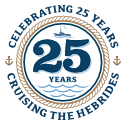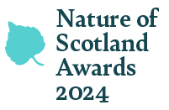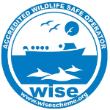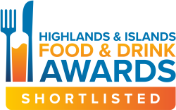We are delighted to report that our wildlife sightings have been the best ever this season, not just in numbers but in the amazing nature of the encounters. We don’t think there is any more wildlife around than normal, although species do fluctuate; the winning factor is the combined experience and knowledge of our crews. We know all the hotspots for minke whales, basking sharks, dolphins, otters, eagles, porpoises, red deer and a host of other species. If the wildlife is there, we are very likely to find it! Our expertise is just as important on our shore trips as when at sea. Apart from spotting wildlife while on land we will find and identify plant life and insect life as well.
Sightings will be very influenced by the month and itinerary of the cruise. Many bird species arrive each year to nest on Hebridean islands and St Kilda. Puffins can be seen on the sea surface near land and nesting onshore in burrows from the end of April until the beginning of August while other seabirds nest in colonies on cliffs from the Treshnish Isles to St Kilda. The various species of term arrive early May and leave in September while Manx shearwaters are already on the Isle of Rum breeding in early spring and set off again for South America again in July.
Basking Sharks are not normally seen till the middle of July but can be earlier. Dolphins can be seen at any time but more often and in bigger pods from August onwards due to the fact the fish (such as Mackerel) are forming bigger shoals at this time.
Minke whale, common dolphins, porpoise, grey and common seals were spotted on almost every cruise while the rarer cetacean sightings are likely to occur off the Islands of the Outer Hebrides. Rarer dolphins such as Rissos dolphins and white-sided dolphins are seen there, also Orca although these have also been seen in the Sound of Mull. A humpback whale was seen
The best sighting this season was off the coast of Arnamurachan. It was late August so we knew fish were gathering in large shoals and when we saw a large number of gannets diving, we quietly went to take a closer look. As we approached, thousands of seabirds could be seen diving on the shoal; several hundreds each of Manx shearwaters and gannets along with huge numbers of guillemots. As we soaked in the scene, over 300 common dolphins arrived to swim around the boat and then to cap it all, 2 large Minke whales circled the boat, ‘gulp feeding’. The water was literally boiling with birds and cetaceans feeding on the fish. It was the most magical experience and everyone on board was enthralled.
For a variety of wildlife, one of the best locations is the Small Isles. It is very easy to spot red deer on Rum and on Canna our guests are guided to visit the Stac on the south side of the island with nesting puffins. Our policy of accompanying our guests onshore with a wildlife specialist ensures they have the best wildlife experience possible on every shore excursion
Our cruises to St Kilda are always very special for both crew and guests. Owner and Skipper Rob has been to St Kilda over 200 times and has passed his knowledge on to the crews. They know where all the different species nest in huge numbers and our perfectly designed vessels can get within metres of the cliffs. Ashore, they can find birds from the St Kilda wren to the Great Skua and take our guests to the best places to watch the wildlife, including observing cetaceans in Village Bay from high above.
Here is a summary of wildlife sightings 2017
Cetaceans:
Minke whales (every trip), Bottlenose dolphins, Common dolphins (every trip), White beaked dolphin, Risso's dolphins, Harbour porpoise (every trip), Humpback whale
Other marine animals:
Basking shark, Sunfish, Common seal, Grey seal, Otter,
Land animals:
Red deer, Roe deer, Red squirrel, St Kilda mouse, Stoat, Feral goat
Birds of Prey:
White-tailed eagle (every trip); Golden eagle, (several sightings); Buzzard, Sparrowhawk, Kestrel, Hen harrier, Peregrine falcon, Tawny Owl; Barn Owl
Seabirds:
Gannets, Fulmars, Common guillemots, Black guillemots, Razorbills, Puffins, Storm setrels, Great skua, Arctic skua, Pomarine Skua, Common terns, Arctic terns, Kittiwakes, Common gulls, Herring gulls, Lesser black-backed Gulls, Greater black-backed Gulls, Manx shearwaters, Shags, Cormorants
Wildfowl:
Little grebe, Eider, Widgeon, Teal, Mallard, Greylag goose, Canada goose, Whooper swan, Mute swan, Shelduck, Goosander, Red breasted merganser, Grey heron, Great northern diver, Red throated diver
Waders:
Oystercatcher, Curlew, Wimbrel, Redshank, Common sandpiper, Snipe, Ringed plover, Turnstone, Dunlin
Birds on land:
House sparrow, Tree sparrow, Greenfinch, Chaffinch, Goldfinch, Blue tit, Great tit, Coal tit, Long-tailed tit, Goldcrest, Robin, Dunnock, Starling, Crossbill, Hooded crow, Carrion crow, Raven, Rook, Treecreeper, Jay, Greater Spotted woodpecker, St Kilda Wren, Wren, Meadow pipit, Rock pipit, Corncrake, Dipper, Grey wagtail, Pied wagtail, Stonechat, Wheatear
Butterflies:
Red admiral ; Peacock; Small white; Large white, Speckled wood; Dark green fritillary; Common blue, Scotch argus; Green veined white; Ringlet; Meadow brown; Small tortoiseshell
Some of the flowers identified on our shore trips (list provided by wildlife guide Nigel Spencer)
Butterwort, Bluebell, Birds Foot Trefoil, Bog Asphodel, Bog Cotton, Sea Campion, White Campion, Red Campion, Pink Campion, Celandine, Centaury, Cuckoo Flower (also known as Ladys Smock), Field Gentian, Harebell, Yellow Flag Iris, Kidney Vetch, Ragged Robin, Scabious, Red Bartsia, Common Sundew, Primrose, Ragwort, Silverweed, Thrift, Wild Thyme, Tormentil, Dog Violet, Yellow Rattle, Common Spotted Orchid, Northern Marsh Orchid, Heath Spotted Orchid























A delightful, well managed trip! I particularly enjoyed the wildlife knowledge and skills of Lyndsay, the cooking of Will, the highly professional stewarding from Jasmin and the company and positivity of Chris. Every aspect of Hebrides cruises is well thought through and overseen with care and rigour by Rob. The company was great too. Emma Jane is a poem of a boat who sits beautifully in the water and has terrific circulation and lounge spaces in addition to lovely cabins.
Philippa Cordingley: 12 April 2025In Search of Seafood: A Hebridean Gourmet Cruise